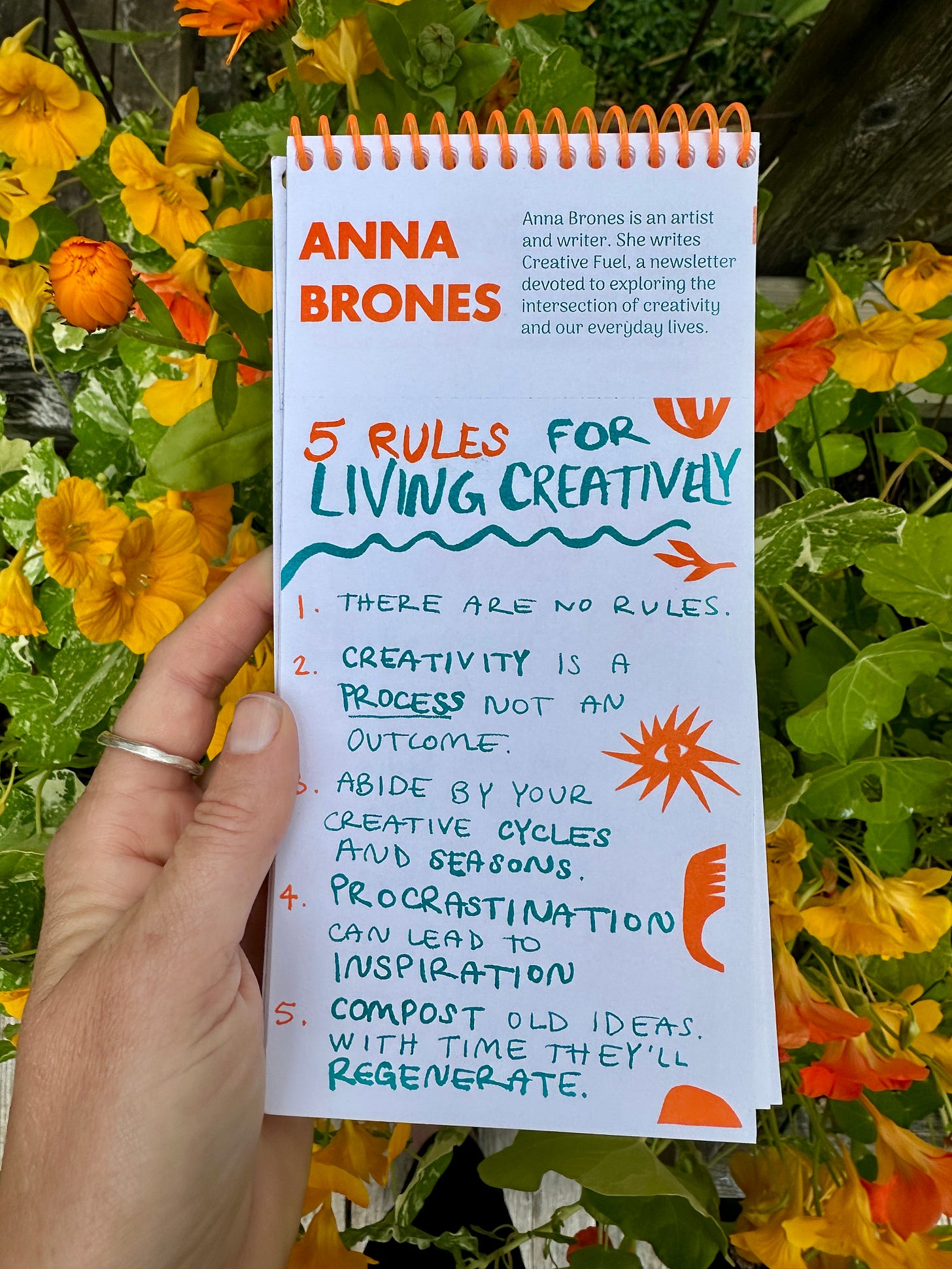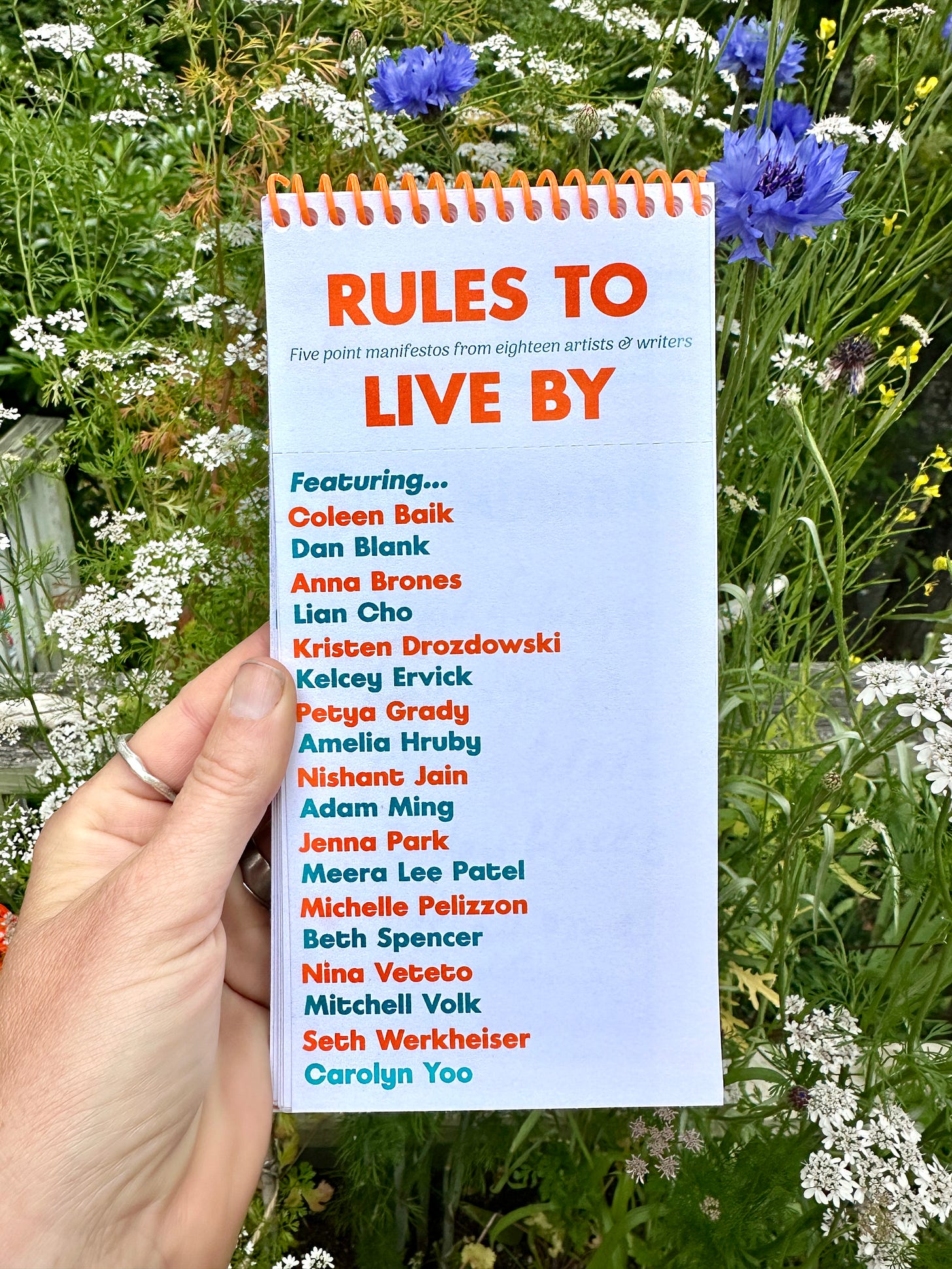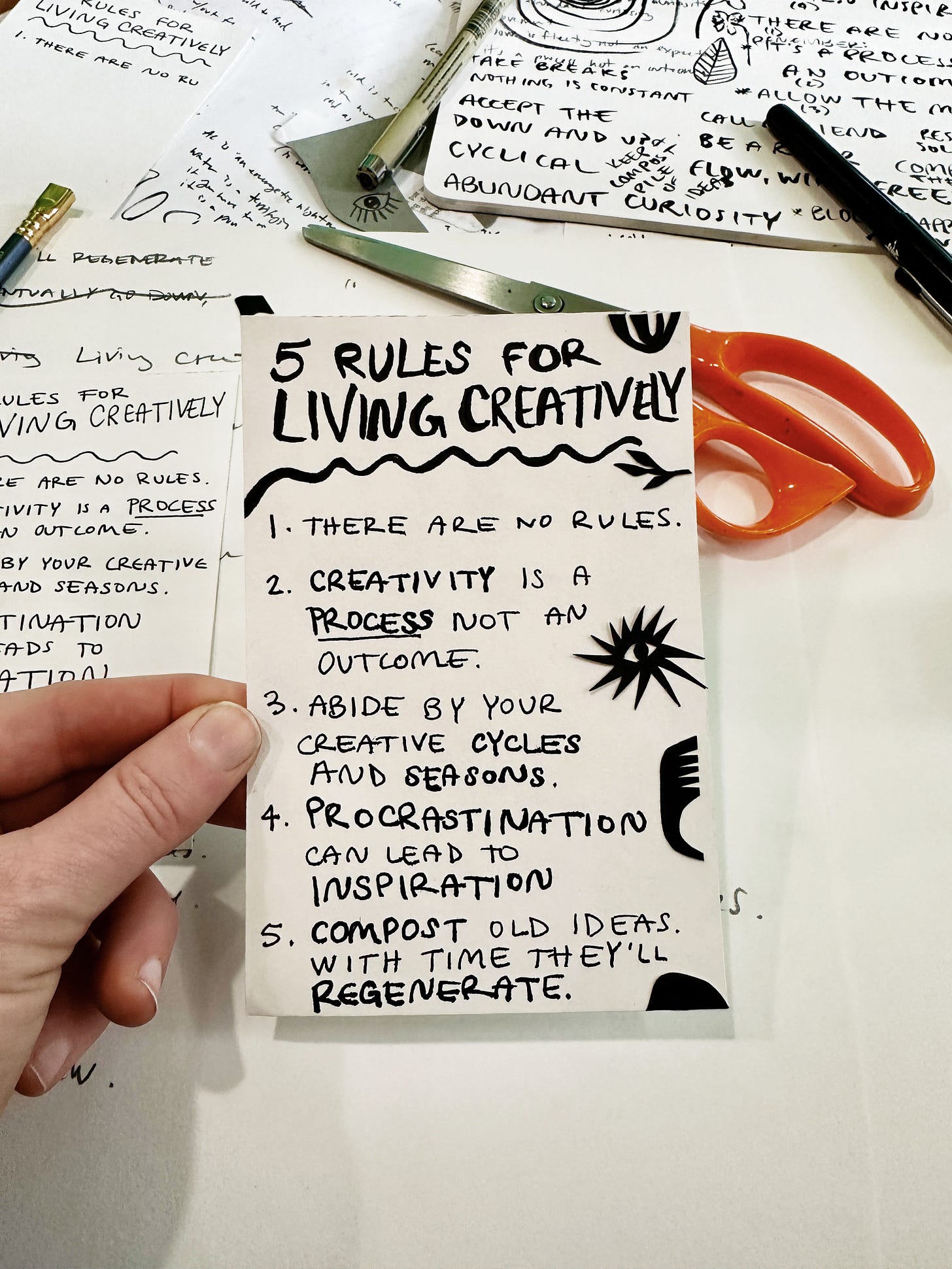5 Rules for Living Creatively
A zine full of creative manifestos + a conversation with artist Carolyn Yoo.
Isles of Curiosity and Wonder Card Set and the Wildflowers Card Set are back in stock // If you didn’t catch the Isles of Curiosity and Wonder Midsummer Creative Retreat, you can take part on your own time. Find the archives here.
Hello friends,
A few months ago
reached out and asked if I would want to contribute to a collaborative zine called Rules to Live By. Of course I did!She was planning on making them with a risograph printer, a sort of combo copy machine/screen printer. I haven’t done any riso printing myself, but it’s at the top of the list of things I want to try. This would be a nice way to at least see what a riso printed project could look like.
The prompt was simple: “handwrite a short "5 Rules for ____" manifesto.” As with pretty much all my projects I said yes immediately and then the deadline snuck up on me and I hadn’t made anything.
What did I want 5 rules for? “Living creatively” I decided. Not 5 Rules for Making Art or 5 Rules for Being an Artist or 5 Rules for Writing, but something that was hopefully a little broader and all-encompassing. A list that would encourage creativity at every turn. Also: I needed to put it together quickly so that Carolyn had time to included it.
We were instructed to write in black, by hand, on a piece of 4x6” white paper. I cheated just a little bit (please refer to rule #1) and added some tiny papercuts for good measure. Carolyn compiled all the lists, and made the zine on a risograph printer.
When the finished zine finally showed up in my mailbox, I was thrilled about how the orange and turquoise made things pop. A simple change of color had entirely altered the feel of the list.
Here’s what it looked like before I scanned it (complete with all of my assorted notes and drafts which you can see behind).
5 Rules for Living Creatively
There are no rules.
Creativity is a process not an outcome.
Abide by your creative cycles and seasons.
Procrastination can lead to inspiration.
Compost old ideas. With time they’ll regenerate.
After I wrote the whole list and glued down the tiny papercuts, I looked at it in finished form. I realized that what I really wanted to say for #4 was “procrastination leads to inspiration.” Clearer, more succinct.
But I decided that I did not need to re-make the entire thing and I could embrace a bit of imperfection (another rule that could be on the list).
I don’t know that this is my forever list, but it felt right in the moment because they were the reminders that I needed. I could regularly come up with new lists of 5 Rules for Living Creatively depending on how I am feeling about my own process.
For example, this week:
Make stuff with your hands.
You are a human, lean into it.
Making something bad is proof you’re making something.
Creative moods ebb and flow.
Rest is required.
If you’re feeling like you need a little direction in this moment, why not make your own 5 rules list? You might find some unexpected clarity you didn’t know you had.
The zine is sold out (but you can still get the digital version), which I know is bad news for those of you who want to buy one, but it’s great news for Carolyn! I did want to learn more about Carolyn and her work, so today I am bringing you an interview with her. We talk about making art for money, zine-making, analog work, and we learn a little more about risograph printing. As you’ll read, she also has a really great framing of creative seasons.
I hope you enjoy reading it.
-Anna
ps: there are so many amazing artists and writers are featured in this zine so be sure to check out their work as well:
INTERVIEW WITH CAROLYN YOO
Anna Brones: You used to work as a software engineer and last year you quit to take a creative sabbatical, but also to commit to a change in your work life. You recently wrote that you had "dreams of a free and expansive life as a self-employed creative." How has that view of self-employed creative changed from those early days to now?
Carolyn Yoo: At first I romanticized the validation I could receive being a 'full-time artist'. I've since realized that juggling all the balls required to make this happen tends to pull me away from my creative spirit. I've been able to try a bunch of things since quitting—increasing paid offerings on my Substack, teaching workshops, selling at markets. I've greatly enjoyed all these endeavors, and they've taught me a lot about different ways to share work and connect with people.
But right now you’re catching me at an inflection point. I’m feeling a bit guilty about not dedicating more to my own creative practice and am itching to push myself and make more personal work. I'm deliberately pulling back from pitching and selling for the time being so I can prioritize developing new art for myself.
You made a zine all about how to keep your hobby from becoming your job. As you work at building out your own creative small business, how do you ensure that you have time for "fun creative work" and "work creative work"? How do they inform each other?
Thinking in terms of seasons really helps relieve time pressure and think more cyclically. One’s seasonal output might follow the natural world—winter for incubating, spring for hatching an idea, summer for collaborating and promoting, autumn for reflection and release. After a few years of experimenting with and identifying my flow, I’ve realized that winter and summer are my inward seasons for personal projects. Spring and autumn are when I am more willing and ready to share my work and teach others what I’ve learned.
Something else I’ve been thinking about is how “work creative work” can be tedious but automatic because of our expertise, whereas “fun creative work” brings up more fear. That’s certainly the case for me when leaving my comfort zone to try different materials or subject matter. One of my favorite newsletters
recently wrote a series on failure tolerance, which got me thinking—the person I am most scared of failing is myself! But an artist also needs to meet the page and fail in order to push what their “work creative work” can become.
As a creative who is working at building their small business, but also being mindful of the constraints of capitalism and making it as an artist, what are some things that you think about when it comes to creativity and money?
One thing that I try to be conscious of is selling things that I would be excited to purchase and support myself. I love paper and analog, but I also want to be environmentally conscious and avoid too much clutter in my home—so my preferred method of engaging with art is usually through buying “low profile” books and small prints as well as attending events and workshops.
I’m still figuring out the right balance of what income streams to focus on. There are so many avenues for an artist to go down and it’s easy to get overwhelmed. I am grateful to have savings to rely on as I experiment and see what works best, and I also love giving things for free. Most issues of my newsletter are free and I know I lose paid subscribers because of that. But even if some decisions aren’t financially lucrative in the short term, I try to be generous whenever I feel called towards it. I remind myself it’s a long game.
Ok enough money talk! Let's chat zines. You've made several of them and this spring you did a zine challenge in your newsletter, with zine workshops and more. What first got you excited about zines? Can you remember the first zine you read?
I first heard of zines in my high school punk phase. I have huge admiration for Kathleen Hanna, lead singer of Bikini Kill and pioneer of the riot grrrl movement. I would page through Bikini Kill zine archives online and make my own inspired pages in my art journals. I love all printed matter, but discovering zines was especially exciting because zines are so spontaneous and can be entirely made and published by one person.
You made the most beautiful collaborative zine that I got to be a part of called Rules to Live By. What does collaborating with people add to your creative practice?
Thank you! I don’t often seek or suggest collaborations in my practice, but I was eager to use my risograph experience to share some of my favorite artists’ and writers’ work. I came up with the idea for a book of creative manifestos while eating breakfast one morning and sent off emails in the next hour before I had any time to second guess it.
Artists on the internet are already so great about supporting each other’s work, and it is especially true for a collaborative project. I loved the challenge of unifying everyone’s manifestos and making it all feel cohesive through the printed format. It got me out of my own head as I was focused on uplifting contributors’ work instead.
In order to create, we need to see that creativity comes from a place of possibility, not judgment. - Carolyn Yoo
I was so excited that you were printing that zine with a risograph printer, which I have always wanted to try but never had the chance to. It was so fun to send you a scan of black and white text and then see this fun, colorful final edition when it was printed. Tell us a little more about risograph printing. What initially drew you to it?
Risograph printing is a wonderful technique that is a hybrid between screenprinting and a copy machine. I was drawn to riso for its ability to print wonderfully vibrant and imperfect textures at a low cost, and used it to print my first zine. I recently got to dive deeper and get a lot more comfortable with the riso printer through a ten-week workshop. During that time, I went to the lab as often as I could, printing three zines (one of which was Rules to Live By) and several prints.
Learning color separation and printing each layer individually taught me a lot of technical knowledge that now informs my art practice. I sometimes fret that my illustrations are too minimal and naive but I think riso lends itself well to adding life and charm to the simplest art.
Part of what I really like about your work is your ability to mix analog and digital. You wrote about spending a month trying to be as analog as possible. Calendars, lists, etc. it all went in a notebook. That was a few months ago and I am wondering what changes you've held on to after doing that experiment?
Quite a lot! I’ve been spending less time on the computer than I used to, and I’ve continued to use notebooks to plan and document. Though analog takes more time, it also allows me to feel more spacious about time. Because digital is so quick and optimizable, I was constantly doing too much and cramming things in. The slower pace of analog helps me solidify thoughts and be more patient in my art practice.
What do you think blocks people from exploring their own creativity?
I don’t think there is any creative block that isn’t essentially fear. Even in the starkest conditions of limited time, space, and material, humans show immense capacity to express their creativity. In order to create, we need to see that creativity comes from a place of possibility, not judgment. We need to give ourselves permission to make whatever comes out of our hands, even if it’s “bad”, and to have people in our lives (or online!) who honor and respect the spirit of that art. Gradually, we keep doing that and get closer to the vision of the art we want to make, though we likely won’t ever fully reach the destination.
What does it mean to be an artist?
An artist uses their senses and guides others to pay attention to what they find important. I love how Maria Popova defines it: “Artists are simply people who feel life deeply in all of its dimensions, who are awake and alive to both its tragedy and its transcendence, who put their heightened sensitivity in the service of wakefulness and aliveness for others.”
What does it mean to be creative?
Being creative means having ideas and then realizing those ideas in some way. Everyone can be creative, and creativity can happen in any field or community, not just artistic ones. Creative people like to try things and enjoy the process of trying, rather than simply doing things as efficiently as possible.
Thank you to Carolyn for doing this Q&A. Support her work by subscribing to her newsletter and be sure check out her shop.
RESOURCES + INSPIRATION
Here is what Carolyn has on her radar right now:
Do Ho Suh’s Walk The House at Tate Modern in London
Estee Zales’ Journal Rash
Hadley Queen on Youtube
The Unreality of Memory by Elisa Gabbert














Love this. My list as of this moment:
1. Follow you curiosities.
2. Let other people decide if it's good. Just keep making.
3. Choose the idea that lights you up.
4. Take breaks. They're good for you.
5. If you're not having fun, change something.
1. There are no rules (always and forever the first rule)
2. Use what is in front of you
3. Keep creative tools handy
4. Enjoy creative chaos
5. Please yourself